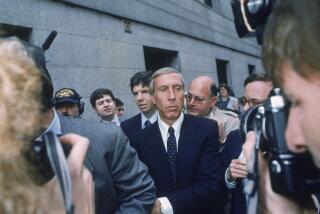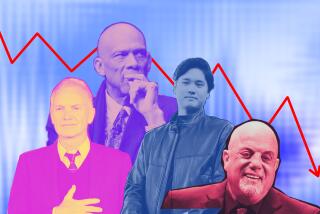‘91-’92 Business. A look back and a look ahead. : What Investment Pros Learned During 1991
Even investment pros learn something each year. We asked a few to ‘fess up and tell us their biggest investment mistake in 1991 or the most valuable lesson they learned.
Ed Bernstein, manager, Prudent Speculator small-stock mutual fund, Los Angeles.
Bernstein was one of many pros who owned shares of Florida-based cosmetics retailer Cascade International, a hot stock that turned out to be a sham. The shares soared from a low of $2.50 to a high of $11.75 in 1991 on glowing forecasts by the company.
Now Cascade is in bankruptcy, and Bernstein has written off his 135,000 shares, which at their peak accounted for 8% of his $13-million fund. He has enough winners in the portfolio to cushion the fund--it still was up about 57% in 1991--but Bernstein admits that he’s been humbled and should have known better.
He says: “The lessons are, don’t ever own too much of one stock in your portfolio, and adhere to the ‘cockroach principle’ “--that is, when one ugly problem suddenly appears in a company, assume that there are many more under the surface, and sell fast.
Howard Marks, junk bond portfolio manager, Trust Co. of the West, Los Angeles.
Late in 1990 and early in 1991, Marks correctly figured that it was time to buy depressed corporate junk bonds. “Three years from now, people will say they can’t believe things were ever available at those prices,” he told clients in a letter last January.
Truth is, within three months people were lamenting as much: Junk bonds staged a tremendous rally with the stock market last winter, and for all of 1991 the average junk bond price soared more than 20%. With interest earned, the total return on junk bonds was 34% for the year.
For Marks, it was a reminder of the futility of trying to time market moves. When you recognize a good investment, he says, you buy it--because “while it’s possible to be right about value, it’s impossible to know in which time frame the discrepancy (in prices) will close.”
Robert Doedde, manager, Centurion Capital, San Diego.
As a professional short-seller--someone who bets that high-flying stocks of lousy companies will plunge--Doedde gets hurt when such stocks defy reason and fly higher instead of falling.
The sobering lesson of 1991, he says, is that “all bad stocks can go up at once. “
Indeed, short-sellers were murdered last year as many of the stocks they targeted for collapse--often for good reason--instead rocketed with the new bull market.
Doedde, who manages $125 million, notes that “the theory had been that all good stocks can go down at once, but that all bad stocks don’t all go up at once.”
Another theory out the window, he says.
Jim McCamant, editor, Medical Technology Stock Letter, Berkeley.
A longtime follower of biotechnology stocks, McCamant notes that they have astounded Wall Street by climbing consistently for three years straight.
In 1991, he says, “the lesson we learned again is how important momentum is in a stock. It’s amazing how far stocks can go once they gain that momentum.”
While the biotech industry’s bears argue that the stocks already have reached the stratosphere, McCamant notes that investors’ love affair with the industry enabled the companies to raise billions of dollars in 1991 by selling new shares.
The irony of the bear case now, he says, is that “the outlook for the industry is so much improved because of the billions raised” last year. As that money is pumped into new drug research, the resulting discoveries are likely to create a new wave of investor interest in the stocks over the next few years.
John Rogers, manager, Ariel Capital Management, Chicago.
While some money managers were burned last year by holding losing stocks for too long, Rogers says his biggest mistake was selling good stocks too early.
“What I relearned was, ‘Don’t act in passion,’ ” says the manager of $1.6 billion in assets. “Just because a company reports disappointing earnings for one quarter, you don’t want to bail out too quickly.”
A case in point, says Rogers: restaurant chain Morrison Inc., whose stock was tripped after an accounting shift hurt earnings for a quarter. Rogers sold on the news, only to see the stock rebound. It closed the year at $26, nearly double its 1991 low of $13.50.
Greta Marshall, manager, the Marshall Plan, Sacramento.
Marshall’s firm oversees a $60-million portfolio of small stocks, which of course were 1991’s stars. Like many money managers today--and a growing number of individual investors--Marshall uses computers to routinely screen the market for stocks with the qualities she seeks. From a list of 2,000 stocks, Marshall’s computer culls a portfolio of 120 names.
The problem with computer stock-selection programs is knowing when to trust your human instincts over the computer’s cold objectivity, Marshall says. Looking back on 1991, she says she regrets overruling the computer’s mid-year signal to make a quick shift out of one group of small stocks and into another. The move would have produced a tidy extra profit.
“It wasn’t so much a problem of human emotion as rigidity--saying that I had a long-range plan and not wanting to deviate from it,” she says. The lesson is that investors should stay flexible, Marshall says--you may be able to take advantage of short-term opportunities without necessarily messing up your long-term plan.
New Year’s Predictions: Hot-and Not-in 1992 Don’t feel like reading alot of year-end investment stories? Here’s the solution: 13 potentially hot business / investment trends for 1992, and 13 once-hot trends now headed for the junk heap-or perhaps already there. What’s In BankAmerica Isured muni bonds High-quality small stocks The German mark German bonds Deflation fears Small new S&Ls; Smart blue chips Discount brokers Gaining market share Refinancing loans Homes under $200,000 The Koreas What’s Out Security Pacific Mello-Roos muni bonds Just ANY small stocks The U.S. dollar U.S. bonds Inflation fears Old ailing S&Ls; IBM and GM Lazy “full-service” brokers Raising prices Taking on new debt Homes over $400.000 Japan
More to Read
Inside the business of entertainment
The Wide Shot brings you news, analysis and insights on everything from streaming wars to production — and what it all means for the future.
You may occasionally receive promotional content from the Los Angeles Times.










